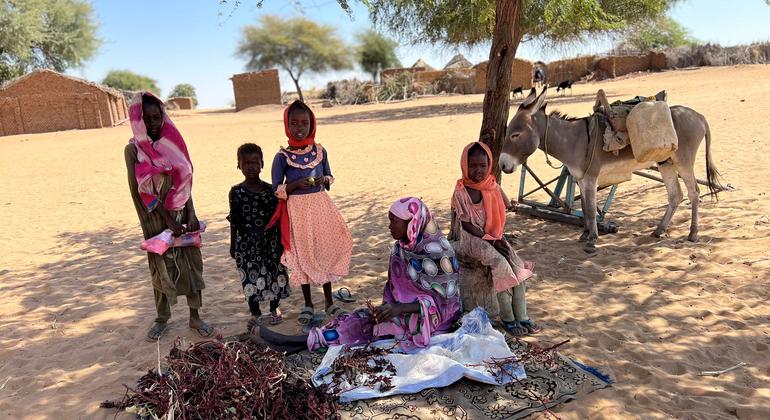Catastrophic famines to double by 2024; Gaza and Sudan worst hit

Updated Global report on food crisis revealed that nearly two million people are currently struggling with the most severe level of food insecurity, classified as Stage 5 on the global IPC scaleacute hunger monitoring
This level represents “severe food shortages and exhausted coping capacity”, with a sudden increase in the risk of acute malnutrition and death.
“As well as causing widespread acute malnutrition and death in the short term, it has major human, social and economic impacts in the long term.“, the report noted.
The report also found that acute malnutrition among children and women in crisis-affected countries remains “persistently high”, with many families unable to afford healthy diets.
The report also notes that improved harvests have helped reduce hunger in several countries, including Kenya, the Democratic Republic of Congo (DRC), Guatemala, Lebanon and Afghanistan.
The report was prepared by a group of United Nations agencies, including the Food and Agriculture Organization of the United Nations (Food and Agriculture Organization), World Food Programme (World Food Programme), United Nations Children’s Fund (UNICEF) and the United Nations International Organization for Migration (IOM), together with humanitarian partners.
Complete collapse in Gaza
Víctor Aguayo, UNICEF’s Director of Child Nutrition, described the situation of severely malnourished children.
During a press conference with journalists at the United Nations Headquarters in New York, he described situation in Gaza is one of the most serious food and nutrition crises in history.
“The nutritional situation in Gaza is one of the most dire we have ever seen.…it is important to remember that nearly half of the Gaza population suffering from this devastation are children,” he said.
Returning from the region last week, he said the impact of the war and severe constraints on the humanitarian response had led to a “complete collapse” of food, health and protection systems, with catastrophic consequences.

Most of the agricultural land in the Gaza Strip has been destroyed by the conflict.
‘There is no doubt’ that famine is ongoing
“The reality is that the diet of children in Gaza is extremely poor. It is estimated that more than 90 percent of children eat only a maximum of two foods per day for weeks or months at a time.in a very serious context… lack of clean water and sanitation,” he said.
It is estimated that more than 50,000 children need immediate treatment for acute malnutrition, requiring the support of health professionals and nutritionists.
“I walked through the markets and neighborhoods, or what was left of the markets and neighborhoods…I have no doubt that there is widespread famine and nutritional crisis.”, he stressed, calling for an immediate ceasefire and continuous access to humanitarian aid.
Rapid Deterioration in Sudan
Máximo Torero, FAO Chief Economist, highlighted rapid deterioration of food security in Sudan.
Ongoing conflict between rival military forces and limited humanitarian access have led to famine in some internally displaced persons (IDP) camps and threaten to spread further. The situation is not expected to improve until at least October.
“Conflict continues to cause rapid deterioration of food securitywith an estimated 26 percent more people facing high levels of acute food insecurity in the June-September period compared to June last year, amounting to 25.6 million people classified in crisis or worse,” he said.
The crisis is also affecting neighboring countries, including Chad and South Sudan, which are hosting large numbers of Sudanese refugees while also facing conflicts and climate-related crises, he added.

Trucks carrying essential food supplies cross from Chad into Sudan through the Adre border crossing.
Access and funding
Arif Husain, WFP Chief Economist, stressed that the burden of the global food crisis is increasing, from 90 million people in 2023 to an estimated 99 million people this year.
He stressed the need for access and funding to effectively address the crisis.
“The first is access – physical access to people in need, safe and sustainable access,” he said, adding “the second is funding to provide support in a sustainable way, for as long as the need exists.”
“If you have one, it is not enough. If you only have access or if you only have money, it is not enough. You need both,he stressed.
Whether it’s war or climate, if we don’t address the root cause, we can’t expect demand to go down.
– Arif Husain, WFP Chief Economist
Address the root cause
Mr Husain also stressed the need to address the root causes of hunger and malnutrition.
“Whether it is war or climate, if we don’t address the root causes, we can’t expect demand to come down,” he said.
Finally, he said that while experts and humanitarians are aware of the situations outlined in the report, there are many other hotspots in similar circumstances with little information or data, such as in Zambia.
“But we can’t say there’s famine there because we don’t have the data. So access — getting the information — is also important.”




